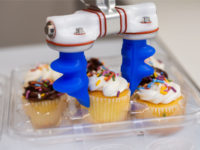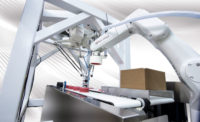Robotics are gaining popularity in snack and bakery applications
An expert from Quest shares the benefits of automated tech in food packaging.

Courtesy of Quest
In the dynamic realm of modern packaging, where cardboard boxes and shrink-wrapped bundles rule the shelves, there's a silent revolution underway. It's a revolution that has seen packaging evolve from a mundane necessity into a technological marvel. Enter the world of packaging automation, a term that's gradually become synonymous with efficiency and precision in the food industry. At the heart of this transformation stands a mechanical marvel – robots, which are orchestrating a symphony of efficiency and innovation, turning the traditional packaging line into a mesmerizing ballet of automation. Which brings us to a rather important question: why has robotic automation had such a profound impact on the way food products are packaged and prepared for distribution?
Increased efficiency
One of the standout advantages of utilizing robotics in food manufacturing is the significant boost in efficiency. Robots excel at performing repetitive and labor-intensive tasks with unparalleled precision and consistency. This translates to higher production rates, and increased throughput. Unlike humans, robots do not need to sleep or take breaks. This means they can operate at full speed 24 hours a day, every day of the year if needed.
Improved quality control
When it comes to handling delicate food products, robots are the epitome of gentle precision. Their consistent and controlled movements ensure that every item is packaged with care, reducing the risk of damage or contamination. The result? Higher product quality and greater customer satisfaction.
Enhanced safety
Robotic packaging systems are equipped with advanced safety features to ensure that all operators are kept safe during operation. This includes things like emergency stops, sensors, guarding, and light curtains to protect workers from ever being in danger of injury. Furthermore, in food manufacturing facilities, robots are replacing the dull, dirty, and dangerous jobs that few people want to do. Repetitive motions and heavy lifting can have a significant negative impact on workers’ overall health. Automating these processes with robotics reduces the amount of workplace injuries and maximizes worker safety.
Cost savings and labor shortage mitigation
While the initial investment in robotics can be substantial, the long-term cost savings provide an outstanding return on investment. Reduced labor costs, increased operational efficiency, and improved quality control contribute to significant savings for food manufacturers. In recent years, we’ve seen many of our customers suffer from labor shortages and high turnover rates. Robotics offer a much-needed and sought-after solution by automating jobs that are hard to fill, thus bridging the workforce gap.
 Common industry applications
Common industry applications
Common applications for robots in food manufacturing can be found in both primary and secondary packaging.
Primary Packaging
On the primary side of food packaging, robots handle crucial tasks that involve direct contact with products. The demand for systems that can load, orientate, stack, and group products into packaging machines like thermoformers, flow wrappers, and vacuum sealers continues to grow rapidly. Whether these products are raw or ready-to-eat, a great deal of precision and accuracy must go into every robotic direct food handling system. These systems are meticulously engineered to comply with all safety and sanitary requirements to ensure that they can be sanitized easily and effectively. Any water or cleaning solutions need proper drainage with no crevices for bacteria to grow.
Some products in the primary space can be quite delicate and fragile. For this reason, robotics integrators are utilizing “soft grippers” on their robots for precise picking without damaging the products. The grippers themselves, too, should be made of food-grade materials. In summary, the advancements of food-safe and washdown compliant systems have made robotic automation a normal occurrence in primary packaging.
Secondary packaging
Robotic automation in secondary packaging isn’t a new thing by any means. Two main applications where we see robotic automation flourish are case packing and palletizing.
On the surface, robotic case packing doesn’t seem too complicated. It’s just putting a product in a box, right? Not exactly. Food manufacturers don’t simply have just one product type and one case type. Modern food production involves a wide variety of product and case sizes, shapes, and weights. These broad variations in product type is where robotic automation is proving its worth with leading food manufacturers. Because of their adaptability, robotic case packers can pack a wide range of products, into nearly any case with precision, efficiency, and reliability. There’s no need to buy a separate machine for each product that you run, product changeover can be as simple as pushing a few buttons on the HMI and changing out the robots’ end-of-arm-tools.
Robotic palletizing is perhaps the most common use for robots in food manufacturing. Regardless of your product specifications, the end goal is to place them on some sort of pallet for transportation. Because manually stacking boxes is an undesirable, back-breaking job, letting robots do the work is a no-brainer. If you find the right integrator, these systems are highly user-friendly, safe, and cost effective. If you’re experiencing high turnover and labor shortages, robotic palletizing can be an ideal solution to safely and efficiently meet your production goals.
Intuitive robotic systems
When delving into the realm of robotic solutions for your packaging needs, one of the paramount factors is the ease of operation. The user-friendliness of your chosen robotic system can have far-reaching implications on the efficiency and productivity of your operations. It is a well-established fact that complex, convoluted systems can pose a significant challenge for operators. These systems may require extensive training, causing delays in their adoption and effective use. Such learning curves can not only be time-consuming but can also become a considerable drain on your resources.
In many instances, businesses are compelled to contract experienced programmers to navigate the intricacies of robotic systems, which can be both a substantial financial burden and a detriment to your bottom line. The expenses incurred by regularly engaging these specialized experts can accumulate quickly, eating into your profits and diverting resources from other critical aspects of your business. Furthermore, relying heavily on external programming expertise may limit your organization's autonomy and responsiveness to changes and customizations required for your packaging processes.
Consequently, the choice of an easy-to-use robotic packaging system is not just a matter of convenience; it is a strategic decision that influences the entire landscape of your operations, from efficiency and cost-effectiveness to adaptability and long-term sustainability.
Looking for a reprint of this article?
From high-res PDFs to custom plaques, order your copy today!







